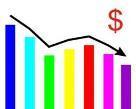Continued Weak US Auto Sales Seen; Asian Car Makers Respond
 |
TOKYO, March 26, 2009; Chang-Ran Kim writing for Reuters reported that U.S. auto industry sales are showing no signs of recovery from a weak start to the year, the president of Toyota Motor Corp said, as rival Honda Motor Co announced further delays to the start of a new factory in Japan.
U.S. car sales slumped by more than a third in January and February, taking them to 27-year lows. That has hammered profits across the industry and driven Detroit stalwarts General Motors Corp and Chrysler LLC to the brink of bankruptcy.
"Annualised sales in January and February were a little above 9 million, and we're hearing that March will be about the same if not worse than February," Toyota President Katsuaki Watanabe told a news conference to unveil the remodelled Crown Majesta sedan.
Watanabe said he could not tell when global car sales would bottom and said he hoped governments around the world would offer incentives to jump-start demand.
South Korea did just that on Thursday, announcing tax breaks for new car buyers and measures for easier consumer financing to support its domestic car industry.
"The announcement is definitely positive, particularly for Hyundai and Kia, which are dominant players in the domestic car market," said Lee Sang-hyun, an auto analyst at Hana Daetoo Securities.
Korean government officials said the measures reflected the importance of the industry, which employs around 1.6 million in Asia's fourth-largest economy.
In Washington, the task force set up by the administration of President Barack Obama was likely to recommend more aid for struggling U.S. automakers, a senior senator said on Wednesday.
Carl Levin of Michigan said on Capitol Hill that "it is clear" more help is on the way and any assistance for GM and Chrysler LLC would be tied to new conditions on restructuring.
HONDA DELAYS FACTORY
Most automakers have been reducing production, scaling back investment and cutting jobs in an effort to preserve cash as the sales slump bites around the globe.
Honda, Japan's No.2 automaker, said on Thursday it will further delay the start of a new factory in Japan by at least a year amid the global auto market slump.
In December, the company said it would put off the start of the factory near Tokyo by at least a year. The plant was originally scheduled to start in 2010, with annual production capacity of 200,000 vehicles.
In a statement, the firm said it decided on a further delay as it still saw no signs of a market recovery.
Toyota, the world's biggest automaker, has said its global production would hit a trough in the January-March quarter, during which it has idled factories for days and weeks at a time while selling cars from its bloated inventory.
Watanabe said Toyota was not planning to have any factory holidays in Japan from May and beyond, when the company hopes to keep daily output above 10,000 units.
Until recently, one bright spot for Toyota has been its gas-electric Prius hybrid, of which the company plans to launch a third generation model in Japan in May.
Falling sales and competition from Honda, with its recently launched Insight, have sparked media speculation that Toyota will sell the next generation Prius at 2.05 million yen ($20,940), or roughly $3,000 less than its smaller, less powerful and less fuel-efficient predecessor.
Watanabe declined to confirm those reports but said the new car came close to achieving a target of reducing the hybrid system's cost to a fourth of the first version, which went on sale in 1997, while costs were also cut on other components and modules in the car.
"The price will take into account the cost cuts, and the competitive environment at the time of launch," he said. "That Honda has come out with a wonderful car like the Insight gives us a big impetus to try to be more competitive."
Watanabe confirmed the old Prius model would be sold alongside the new version, in Japan at least.
"They will have different engine sizes -- 1.5 litres and 1.8 litres -- and we figure there will be demand for the two to co-exist," he said.
Additional reporting for Reuters by Taiga Uranaka in Tokyo, Cheon Jong-woo in Seoul; Writing by Lincoln Feast; Editing by Muralikumar Anantharaman


